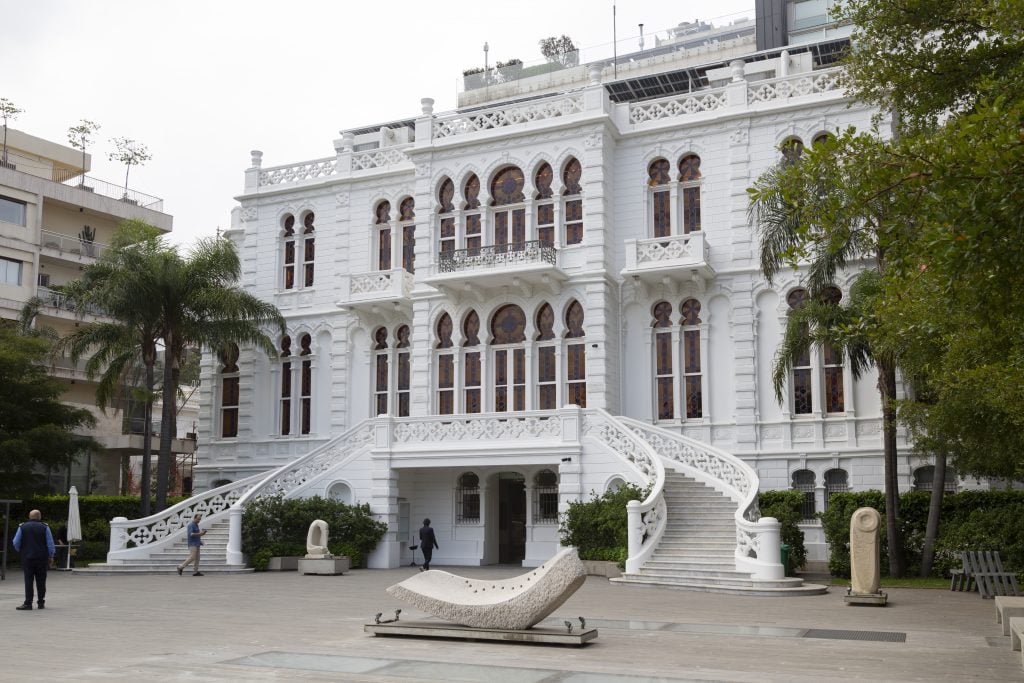Just under three years ago, on August 4, 2020, the iconic stained-glass windows on the façade of Beirut’s Sursock Museum were shattered after several thousand tons of ammonium nitrate exploded in the Beirut Port. As shards of colorful glass lay strewn all over the vicinity, other parts of the 20th-century museum’s architecture, reflecting both Venetian and Ottoman stylistic elements, were destroyed. Inside, cherished artworks were damaged and covered by dust.
“It is a miracle we are reopening,” Karina El Helou, the director of the Nicolas Sursock Museum, told Artnet News. She was appointed director just over six months ago, taking over the role from Zeina Arida, who now heads Mathaf: Arab Museum of Modern Art in Doha, Qatar. “We are a society of survivors. We are still in crisis. But what we have to learn today is to look towards the future and the museum symbolizes that.”
Like hundreds of other buildings across Beirut, the Sursock Museum, Lebanon’s oldest, independent cultural establishment and one of the first museums in the Middle East to celebrate Modern art, was a specter of its former self.
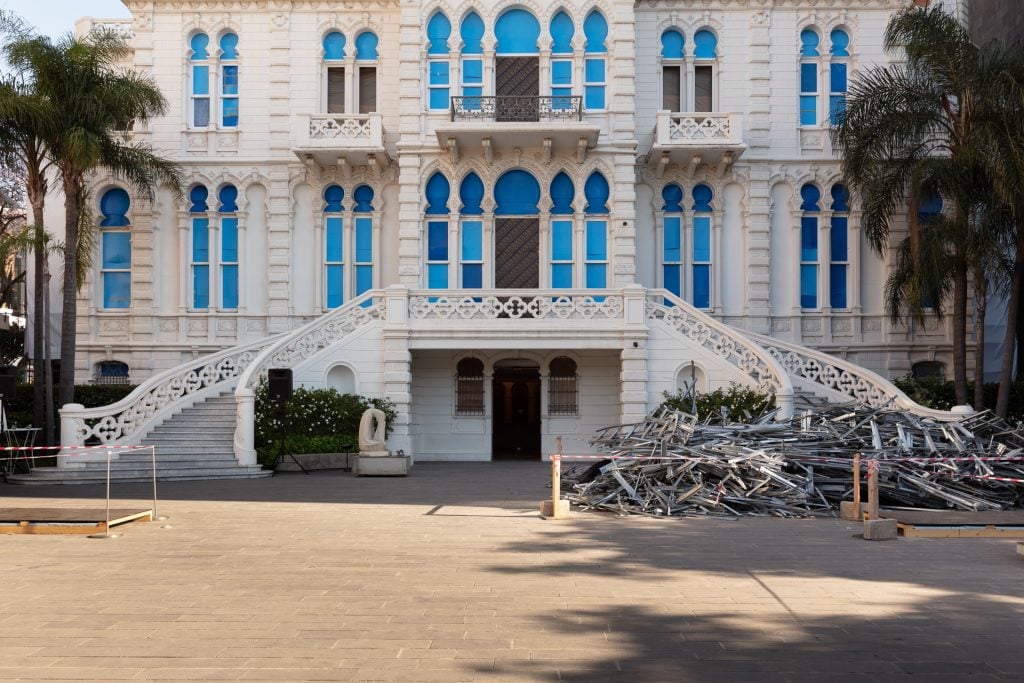
The first and second floors of the building were the most damaged from the blast. The Sursock Museum façade in July 2021. Photo by Rowina Bou Harb. Courtesy of Sursock Museum.
On May 26, during immense political and economic hardship for the country, the Sursock Museum, seemingly miraculously, reopened its doors, rising again from the ashes of the Beirut Port blast.
The museum, with its sleekly designed new exhibition spaces, is a perfect example of the cacophony of struggle and contradiction that constitutes daily life in Beirut, where an ongoing financial crisis has pushed three-quarters of the population into poverty and the government is stuck in a political stalemate.
As in much of Lebanon today—for those who can afford it—the museum runs with the constant drum of generators providing electricity to its many gallery spaces, library, restaurant and café, since the state provides only two hours of electricity per day.
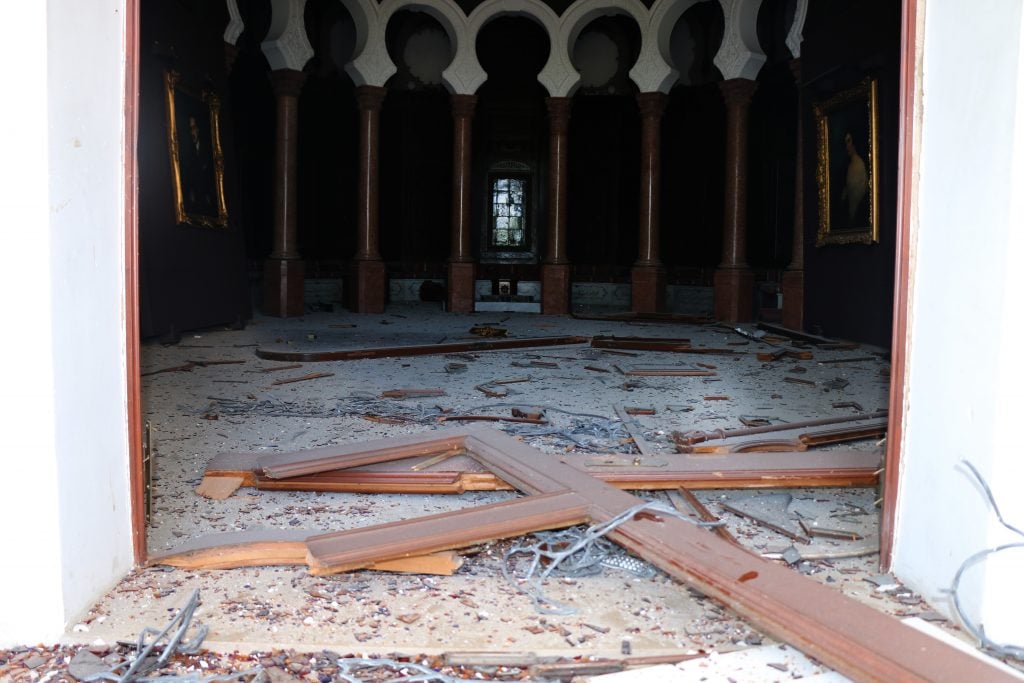
The Salon Arabe after the blast. Image taken on 5 August 2020. Photo: Rowina Bou Harb. Courtesy Sursock Museum.
Meanwhile, outside its doors, street beggars make their rounds amid a fury of traffic, buildings that still carry scars from the blast stand alongside others that are shiny and new, and locals wine and dine at a host of new and old restaurants and cafés.
“It was incredibly challenging to rebuild during a moment of crisis,” El Helou said. “We kept asking ourselves: ‘Will we have all of the materials? Will we finish on time?’ Technically, we are living in a country that has completely collapsed. We have no public electricity; we don’t trust our politicians.”
“Rebuilding the museum became part of our healing: to look into the future and start dreaming again,” El Helou added. “The museum gives us something to celebrate.”
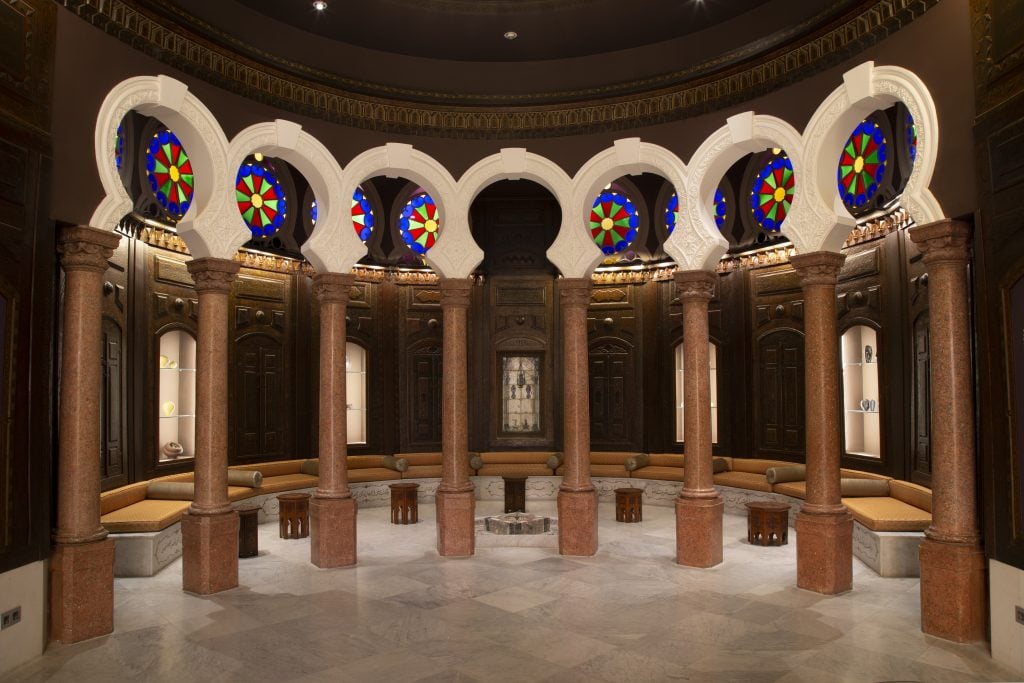
The fully restored Salon Arabe in April 2023. Photo: Christopher Baaklini. Courtesy Sursock Museum.
The museum raised a total of $2,376,751 for the effort following the explosion. The French Ministry of Culture and the International Alliance for the Protection of Heritage in Conflict Areas provided half a million dollars each. The Agenzia Italiana Per la Cooperazione allo Sviluppo (AICS) in partnership with the campaign UNESCO – Li Beirut (for Beirut), gave $1 million. Additional funding was obtained from private Lebanese and international donors.
No money or support has been given by the Lebanese government or the ministry of culture.
Restoration included the repair of approximately 50 artworks, including a portrait of Nicolas Sursock, the Lebanese art collector who died in 1952 and donated his private villa (built in 1912) to Beirut to be used as a museum, and Untitled (Consolation) by Paul Guiragossian. Both artworks were restored by a team at the Centre Pompidou in Paris.
All of the museum’s windows needed to be replaced, as well as its elevators, and the interiors repaired, from doors and ceilings, to its electro-mechanical system. The traditional wooden panels on the museum’s historical first floor, such as those in the Salon Arabe, where Sursock once greeted his guests, also had to be restored.
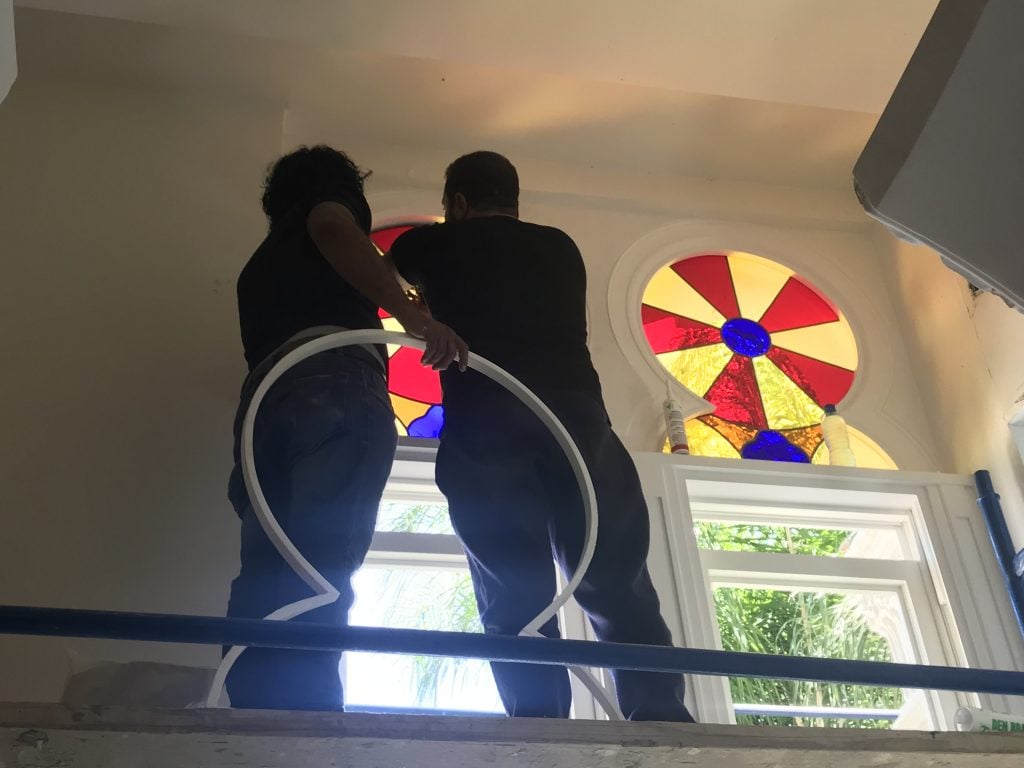
Stained glass installation at the Sursock Museum, July 2021. Photo: Rowina Bou Harb. Courtesy of Sursock Museum.
“Our work to rebuild the museum is to help the Sursock to serve the community once again,” Alessandra Piermattei, Director of AICS Beirut, told Artnet News, adding that the Italian governmental agency has been working in Lebanon since the 1980s. “We want the museum to help the people continue their normal lives and serve as a meeting place for cultural life.”
The Sursock Museum has been an anchor for the city’s cultural scene for decades. During the 1960s, it held an annual Salon d’Automne, an open-call exhibition that featured works by artists living and working in Lebanon. And among the five exhibitions the museum has organized for its reopening is “Je Suis Inculte! The Salon d’Automne and the National Canon,” a show that revisits the legacy of that program.
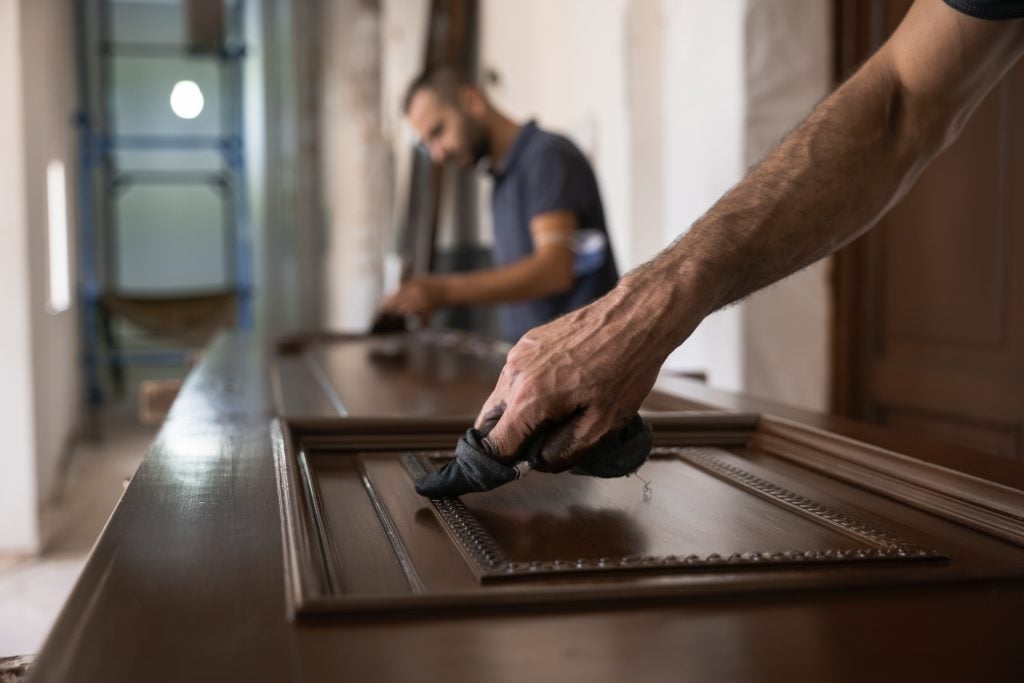
Woodwork restoration of the doors at the Sursock Museum, June 2021. Photo: Vicken Avakian. Courtesy of the Sursock Museum.
Similarly, “Beyond Ruptures: A Tentative Chronology,” explores the museum’s history and the socio-political events it has seen, through works by Lebanese artists such as Jean Khalife, Akrim Zaatari, Aref El-Rayess and Shaffic Abboud.
There’s also a poignant specially commissioned video installation, Ejecta by Zad Moultaka, that recreates the Beirut explosion through digital images of every artwork in the Sursock’s permanent collection.
“We still don’t know the truth behind the blast—the investigations have stopped,” Rana Najjar, a Lebanese media consultant told Artnet News. But, she added: “The museum is healing me. I have so many childhood memories here; it symbolizes the collective memory of the Lebanese people. It is our hope; it is a victory for the people.”
More Trending Stories:
A British Couple Actually Paid Nearly $250,000 to Remove a Banksy Mural From Their Building Due to the ‘Extremely Stressful’ Upkeep
Archaeologists in Hungary Have Uncovered the Remains of an Ancient Roman Doctor Alongside His Surgical Toolkit
The World’s First A.I.-Generated Statue, Cobbling Together the Styles of Five Celebrated Sculptors, Has Landed in a Swedish Museum
Meet the Young Collectors Calling the Shots at the Guggenheim, a Highly Placed Art Worlder’s Anti-Woke Tweets, and More Art World Gossip
An Extraordinary Wristwatch Belonging to the Last Emperor of China Just Sold for $6.2 Million, Setting Multiple Auction Records
A Sculpture Depicting King Tut as a Black Man Is Sparking International Outrage
Archaeologists Have Found a 3,000-Year-Old Bakery in Armenia, After Realizing a Layer of Ash Was Actually Wheat Flour
Why the Supreme Court’s Decision in the Andy Warhol Copyright Case Shows the Dangers of a Sympathy Vote
An Exhibition of Taylor Swift’s Stuff Has Just Opened at the Museum of Arts and Design. Here Are 5 Must-See Displays, Swifties
